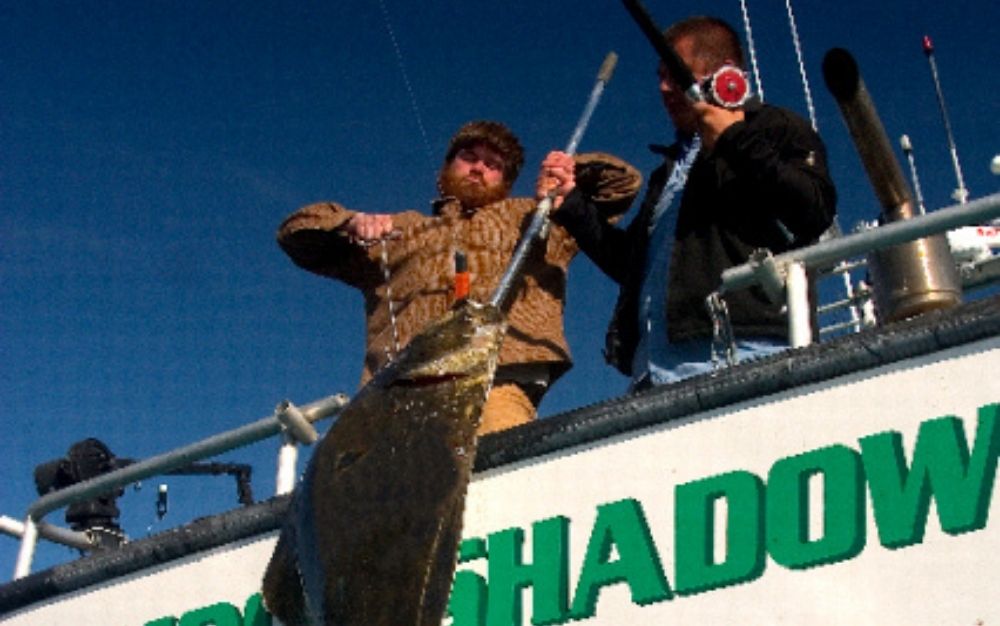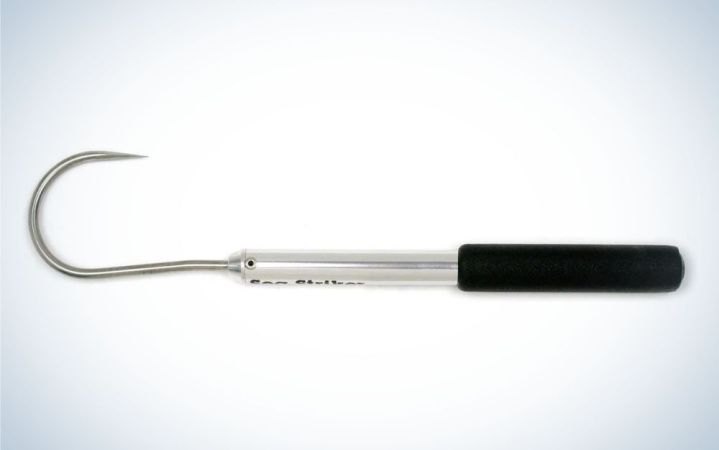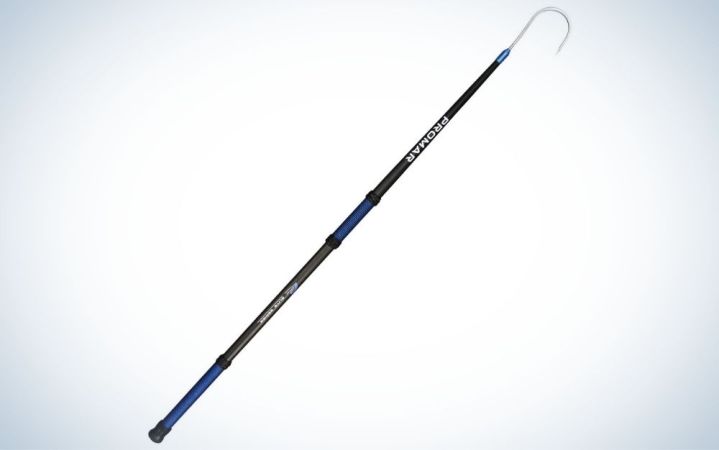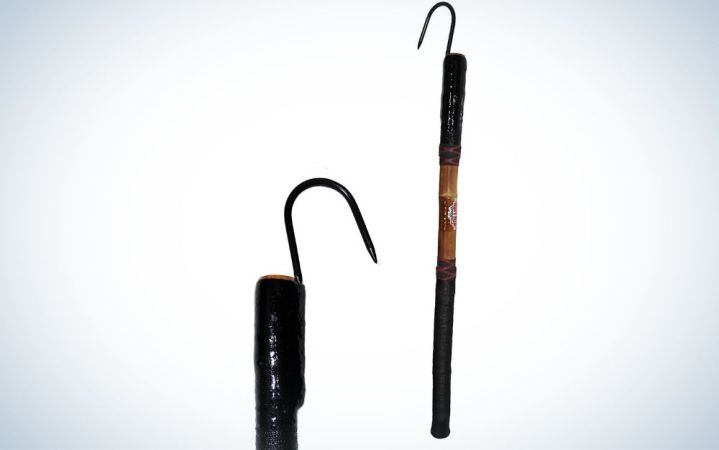We may earn revenue from the products available on this page and participate in affiliate programs. Learn More ›
A big fish is on the line. The rod is bent double. The angler drips sweat and grunts heavily. For every inch of line the angler gains, the fish answers by taking an inch. After an hour, the trophy is boat side. A gaff is in your hands, with victory imminent. Getting that big fish into the boat is the last step in winning the battle…and also the greatest chance for failure. Put the odds in your favor with the best gaff.
- Best All Around: AFTCO Taper Tip Aluminum Gaff
- Best Hand Gaff: Sea Striker Hand Gaff
- Best Carbon Fiber Gaff: Promar Carbon Fiber Gaff
- Best Calcutta Gaff: Kill Fish Calcutta
- Best Budget: Ego Kryptek Gaff
What Should You Look for in the Best Fishing Gaff?
A fishing gaff is one of the most important fishing accessories on a big-game boat. In fact, seasoned fishing crews carry several, each designed for a specific job. That’s because when it comes to landing a fish, a gaff is faster and more efficient than a net. Instead of carefully working the fish close enough to scoop it up with the net, these hooks can snatch the fish out of the water as soon as it swims within range. And, fish too big to fit in a landing net require a hook to subdue. A net is best for smaller fish, or fish that will be returned to the water. But when the big fish hits, it’s time to grab the gaff.
Gaffs are categorized by bite, length, and handle composition:
- Bite. Bite refers to the distance between the point off the hook and the shank. Match the size of the bite to the size of the fish. A two-inch bite is perfect for smaller dolphin and bottomfish. A three-inch bite is a good all-around hook. Use a gaff with a bite over four inches for fish over 100 pounds.
- Length. The classic four-foot design with a three-inch bite is ideal for tuna fishing, wahoo, dolphin, cobia and other fish between 30 and 100 pounds. To land smaller fish, a hand gaff with a two- to three-foot shaft is a perfect fit.
- Handle composition. Handles come in a variety of materials, including wood, aluminum, fiberglass and carbon fiber. Some anglers appreciate the soft touch and shock absorption provided by a wooden handle. Other anglers like lightweight and stiff carbon fiber handles for quick, accurate shots at large fish. Aluminum provides strength and durability, while fiberglass absorbs the shock of striking a fish and flopping it into the fishbox.
Gaffing a fish starts with the leader in one hand and the gaff in the other. When the fish is just below the surface, hold the tool with the hook facing down. Then, reach across the fish, aim for the shoulder or head, and pull the hook into the fish. With one movement, swing the fish out of the water and into the boat or right into the fishbox.
What Is the Best All-Around Gaff?
A four-foot gaff with an aluminum handle and a stainless steel hook with a three-inch bite is the best all around. It’s the most common type used on boats around the world and is perfect for tuna, wahoo, mahi, cobia, yellowtail, and king mackerel. The aluminum handle makes it light, stiff and indestructible.
Best All Around: AFTCO Taper Tip Aluminum Gaff
Classic Hook
Made of lightweight gold-anodized aluminum, the five-foot Taper Tip gaff is light and strong. The tapered shaft ensures strength along the length of the handle and allows it to swing through the air with speed and power. Two foam handles are soft and sticky, making for a solid grip.
What Are the Advantages of a Hand Gaff?
One of the most commonly used tools on an offshore fishing boat is the mighty hand gaff. This short gaff has numerous uses. Pro anglers keep this close at hand by storing it under the covering board or dangling from the fighting chair. Not only does it land smaller fish, but it makes moving fish quicker and safer. To transfer fish into the fish box or out of it, simply pick up each fish with the hook instead of fumbling with the slimy fish. It’s also helpful to have one of these if you have to handle a fish with sharp teeth. Bonus: These can also be used as a dehooker and, in skilled hands, a bottle opener.
Best Hand Gaff: Sea Striker Hand Gaff
Small and Useful
For something smaller, the Sea Striker Hand Gaff is packed with features. An aluminum handle, stainless steel hook, and soft, rubber grip make it easy to use. At one-foot long with a two-inch bite, the Sea Striker is perfect size for smaller boats and fishing kayaks.
What Are the Advantages of a Carbon Fiber?
When it comes to a gaff handle, nothing beats carbon fiber. The material is strong and lightweight, providing a confident feel for a solid kill shot. Landing one big fish after another puts a lot of pressure on the angler, and a lightweight carbon fiber gaff saves energy, preventing you from missing fish.
Best Carbon Fiber Gaff: Promar Carbon Fiber Gaff
Modern Tech Meets Old School
The most advanced tapered carbon fiber shaft with a corrosion-resistant hook will last for years of heavy action. The modern features added to a classic hand-wrapped tuna cord grip finished with a turk head combines style with a solid grip. It’s lightweight, and it floats.
Do You Want a Classic Gaff?
Cut down a broom handle and lash a large hook to the end and you’ve got a gaff. Some craftsmen create gaffs out of more stylish materials, and some of these custom designs are works of art. Ones made with super-strong Calcutta bamboo from India are classic and attractive and have all the efficiency of a modern gaff.
Best Calcutta Gaff: Kill Fish Calcutta
Work of Art
In addition to real Calcutta bamboo, the strongest in the world, anglers appreciate the Kill Fish Calcutta’s soft feel and sturdy construction. A heat-treated stainless hook is stiff, sharp, and corrosion-resistant.
The Budget Fishing Gaff
While fishing gear can get expensive, these specialized tools don’t have to be. Look for an aluminum gaff with a stainless hook and rubberized grip. A cheaper model sacrifices corrosion resistance and builds quality, but for casual anglers, that may be all they need.
Best Budget: Ego Kryptek Gaff
Basic Hook
With an aluminum handle and stainless hook, Ego’s two-foot Kryptek gaff with a three-inch hook has a rubber grip and a tether cord to keep it at hand. The shaft is coated in modern-looking Kryptek urban camouflage.
FAQs
A gaff has to be strong with a sharp hook and made of corrosion-resistant materials to provide years of service in saltwater. The handle should have a textured, soft grip that allows you to keep it in hand. A lighter, stiffer gaff will be easier to stick into a fish and swing into the fish box. Some anglers like a softer handle to absorb shock.
To pick the right gaff, consider length and hook size. A longer gaff up to 8 feet long allows you to reach out and snare a fish farther from the boat, but it is more difficult to control and aim the hook. An average size is four to five feet long to reach over the side of a boat and snag the target. Short gaffs are handy for moving fish around the boat and handling toothy fish. Match the hook size to the size of the fish. A good all-around model has a three-inch hook. Hooks over four inches are reserved for big fish over 100 pounds.
Most fishing gaffs do not have a barb. In most cases, the gaff is used to swing a fish from the water into the fish box. The momentum of swinging the fish keeps it on the hook. When the action is hot and you have to gaff multiple fish, you want the hook to come out of the fish quickly so you can be ready for the next. The most common use for a barbed gaff hook is on a flying gaff. Used to snare giant fish, a flying design features a long handle and a huge detachable hook attached to a heavy rope. To land a giant fish, anglers stick the barbed hook into the trophy then detach the handle. The rope from the hook is tied to a cleat in the boat. Once the barbed hook is in the fish, the crew can use the rope to bring it to the boat.
A Final Word on Gaffs
If you’re in doubt about what size gaff to get, keep in mind that a gaff with a four-foot shaft and three-inch hook is the classic size. Such a gaff, with an aluminum handle for ruggedness and durability, is used on fishing boats worldwide. Now that you know what to look for, start shopping and purchase yours today!








